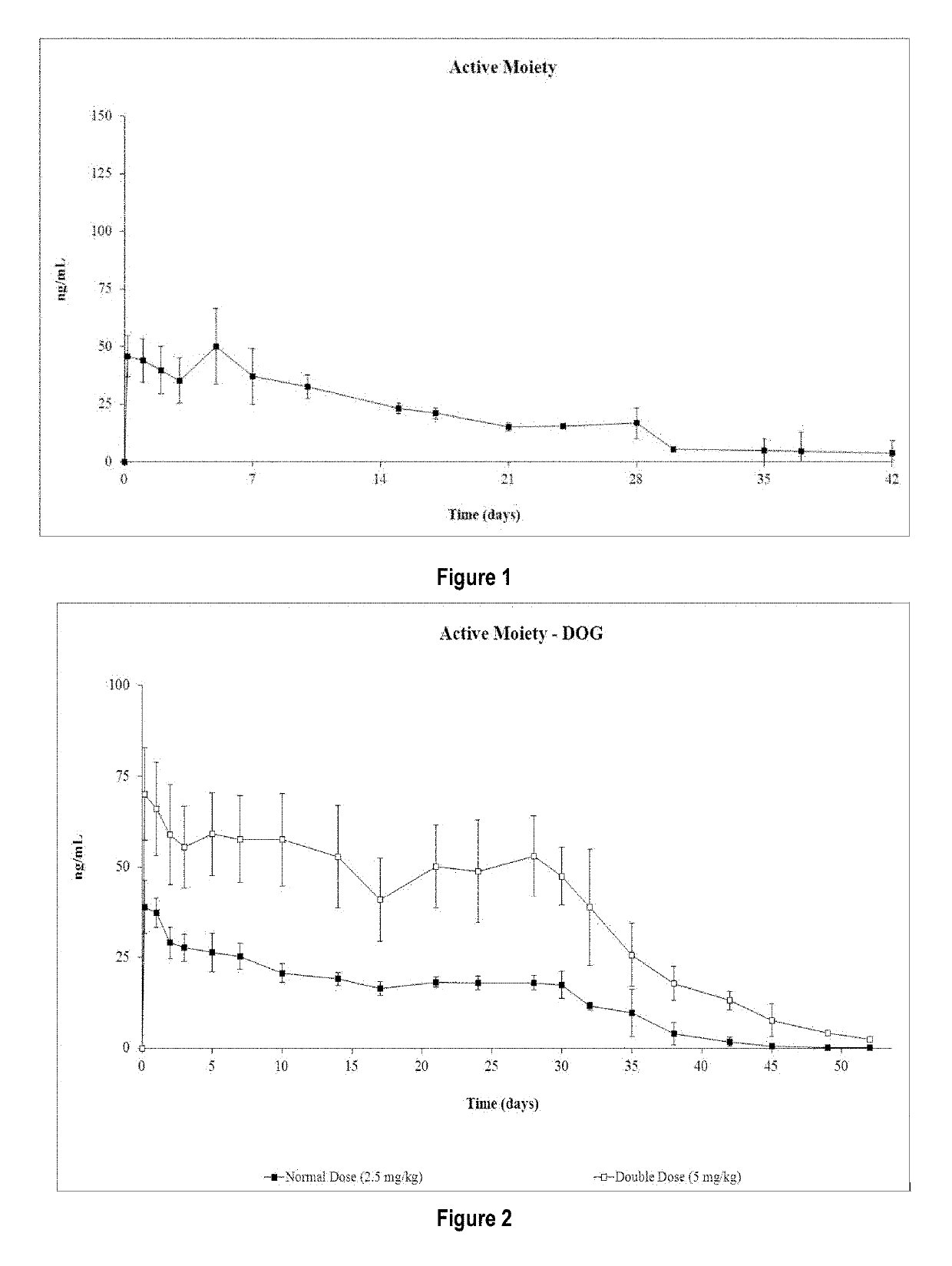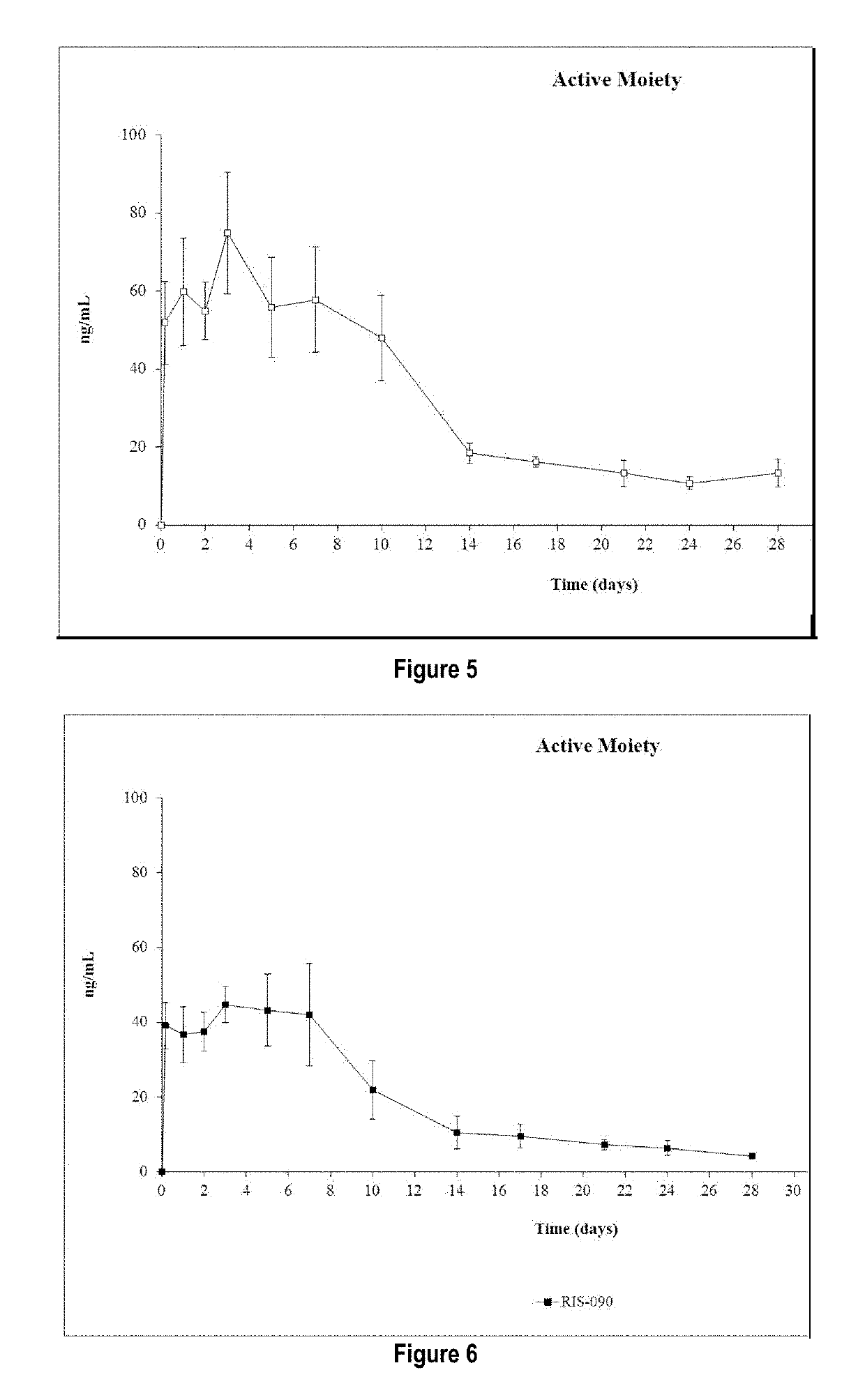Risperidone or paliperidone implant formulation
a technology which is applied in the field of extended release pharmaceutical compositions for intramuscular injection, can solve the problems that the compositions already described in the state of the art do not meet the existing needs of risperidone and or paliperidone compositions, kits and treatments
- Summary
- Abstract
- Description
- Claims
- Application Information
AI Technical Summary
Benefits of technology
Problems solved by technology
Method used
Image
Examples
example 1
mulation with Resomer® 503 without Radiation
[0120]In the present example, the following formulation was prepared:
[0121]
IngredientAmount (mg)FemaleLactic-co-glycolic acid copolymer502.25 ml syringe(N-capped) with 50% content of eachof the two organic acid monomersand a molecular weight of 32 KDa.Risperidone25MaleDimethyl sulfoxide1172.25 ml syringe
[0122]Risperidone particle size was characterized by light scattering and provided the following distribution of particle size: d(0.1)=27.49 μm, d(0.5)=79.90 μm and d(0.9)=176.66 μm.
[0123]Polymer has been characterized for its molecular weight according to the following technique:
Equipment
GPC chromatograph with triple detector (laser diffraction, viscosimetry, refraction index)
[0124]Viscotek® GPCmax VE 2001 GPC SOLVENT / SAMPLE MODULE[0125]Viscotek® TDA 305 TRIPLE DETECTOR ARRAY
Reagents:[0126]Tetrahydrofurane (THF) grade GPC stabilized with butyl hydroxyl toluene (BHT) 250 ppm[0127]Polystyrene narrow standard (preferably about a molecular wei...
example 2
mulation with Resomer® 504 Radiated to 16 KGy
[0159]The present example shows how the polymer molecular weight can be controlled in order to have a sterile formulation with the desired in vivo release properties.
[0160]Filling solid polymer in syringes represents a real challenge in the manufacturing of injectable formulations. The polymer, manufactured as a non-sterile product, requires undergoing sterilization in order to achieve a formulation that can be injected into human beings. Probably the best way to solve this technical issue is to subject the polymer to sterilization by gamma or beta irradiation. Irradiation represents a challenging issue when used biodegradable polymers, as irradiation can disrupt the chains into fractions of smaller size. Control of the polymer molecular weight appears as again as the critical parameter to control the final characteristics of a product after a sterilization process.
[0161]However, chain size reduction by irradiation can be mathematically m...
example 3
mulation with Resomer® 504 Radiated to 25 KGy
[0172]This is another example that shows how the polymer molecular weight can be controlled in order to have a sterile formulation with the desired in vivo release properties.
[0173]A lactic-co-glycolic acid copolymer with 50% content of each of the two organic acid monomers and a molecular weight of 50 KDa was sterilized by beta irradiation at 25 KGy under controlled temperature and moisture conditions. The resultant polymer was characterized for its molecular weight according to the method described in example 1. Molecular weight after irradiation process was 35 KDa.
[0174]
AmountIngredient(mg)Female 2.25 mlLactic-co-glycolic acid copolymer (N-capped)50syringewith 50% content of each of the two organicacid monomers and a molecular weight of50 KDa, beta-irradiated as a bulk with a25 KGy dose achieving a final molecularweight of 35 KDa.Risperidone25Male 2.25 mlDimethyl sulfoxide117syringe
[0175]Risperidone particle size was characterized by l...
PUM
| Property | Measurement | Unit |
|---|---|---|
| size distribution | aaaaa | aaaaa |
| size distribution | aaaaa | aaaaa |
| size distribution | aaaaa | aaaaa |
Abstract
Description
Claims
Application Information
 Login to View More
Login to View More - R&D
- Intellectual Property
- Life Sciences
- Materials
- Tech Scout
- Unparalleled Data Quality
- Higher Quality Content
- 60% Fewer Hallucinations
Browse by: Latest US Patents, China's latest patents, Technical Efficacy Thesaurus, Application Domain, Technology Topic, Popular Technical Reports.
© 2025 PatSnap. All rights reserved.Legal|Privacy policy|Modern Slavery Act Transparency Statement|Sitemap|About US| Contact US: help@patsnap.com



